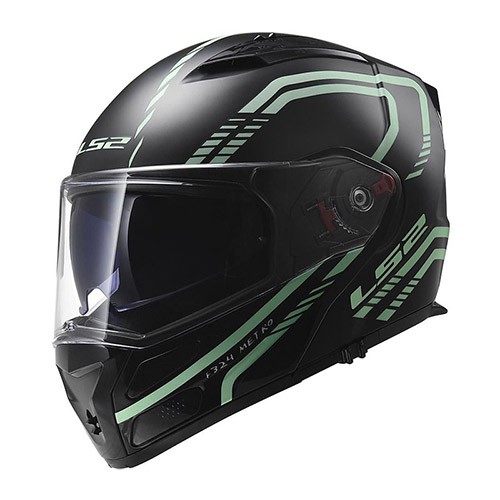
Indian pulled no punches and left no doubt when it came to the bike it had in its crosshairs when developing its latest model. Usually at press intros, we all know what other model(s) could be considered competition, but it’s very rare to have the host manufacturer come out and say it. They usually resist the urge to talk about their competitors by name – and especially won’t mention a specific competitor model – when hyping up their new product.
Indian’s bulked up the Chief with better suspension, better brakes, and a quarter fairing as it sets its sights on the Harley Low Rider S.
Editor Score: 89.5%
| Engine | 17.5/20 | Suspension | 13/15 | Transmission | 9/10 |
| Brakes | 9/10 | Instruments | 4.5/5 | Ergonomics | 9/10 |
| Appearance | 9.5/10 | Desirability | 9/10 | Value | 9/10 |
+ Highs
|
– Sighs
|
Not Indian. Instead of beating around the bush, Indian reps made it perfectly clear which manufacturer and which model they were going after – the Harley-Davidson Low Rider S. Boom. Shots fired. Clearly, the Harley vs. Indian rivalry is showing no signs of slowing down.
2020 Harley-Davidson Low Rider S Review – First Ride
The weapon of choice? Indian’s new Sport Chief. A derivative of Indian’s popular Chief platform, the Sport Chief will look instantly familiar to fans of both the Chief and even the Low Rider S. Long, slim, and athletic, the silhouette is distinctive, and the quarter fairing at the front is an obvious nod towards the Harley. But there’s more to it than that.
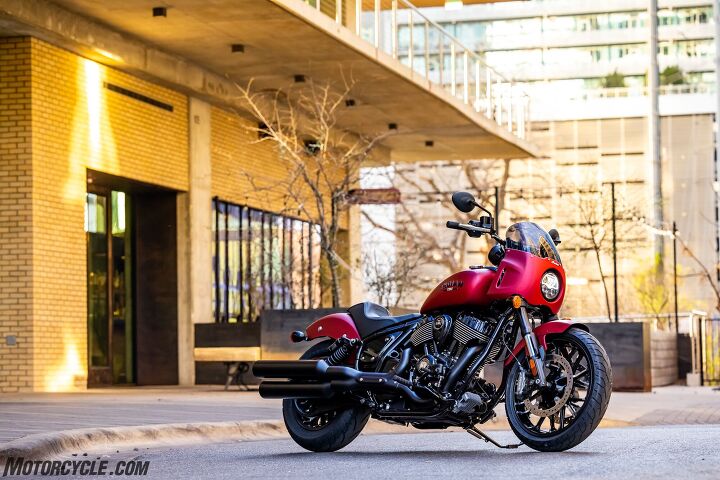
The 2023 Indian Sport Chief in Ruby Smoke.
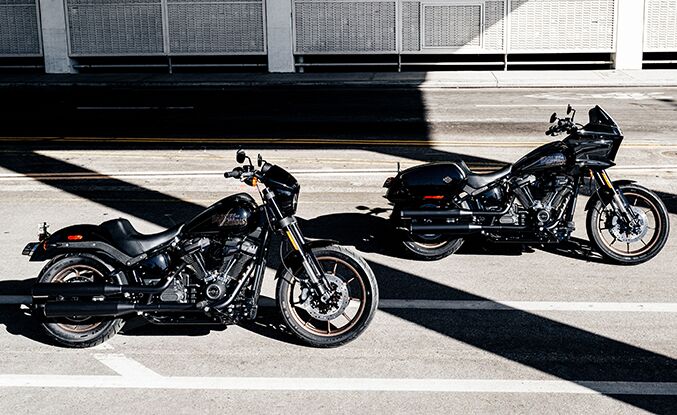
For reference, here’s the Harley-Davidson Low Rider S (left) and ST. Pull the tank badges off and it’d be hard to tell the difference between them.
What Makes A Sport Chief
The recipe for a Sport Chief is pretty simple: make it handle and stop better than the standard Chief. To see how Indian accomplished this, we actually start at the back of the motorcycle and work our way forward. Specifically, the suspension. Indian partnered with Fox to produce a set of twin remote-reservoir shocks with four(!) inches of travel – that’s an inch more than the standard Chief. It only has spring preload adjustability, but it’s worth taking a minute to appreciate the fact that a cruiser has prioritized suspension travel over low seat heights and actually given the back tire a chance to move up and down over bumps instead of blowing through the shock travel immediately and jolting the spine. If compression and rebound adjustments are important to you, the Indian catalog has a set of upgraded Fox shocks that give you that ability.
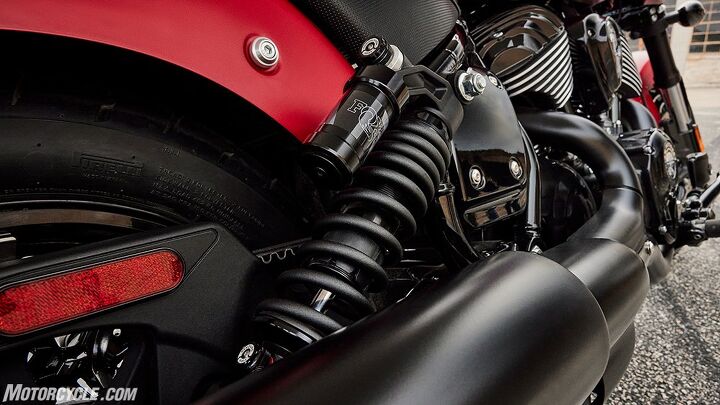
Suspension travel, especially in the back, is usually severely lacking on cruisers. The Sport Chief’s dual FOX shocks have four inches of travel, which really improve the ride.
Apart from giving the rear end more compliance through more suspension stroke, the longer shocks also raise the rear of the motorcycle, pitching more weight over the front end. This accomplishes a few things: first, it helps the bike turn quicker, which is aided further by different triple clamps, giving the bike a 28º rake angle and 4.4 inches of trail. This compared to the 29º rake and 5.2 inches of trail on the standard Chief. The new triples also have 14mm more offset to help clear the fuel tank. Further, raising the rear gives the bike more cornering clearance. Overall, the Sport Chief’s 64.6-inch wheelbase makes it two inches longer than the standard Chief.
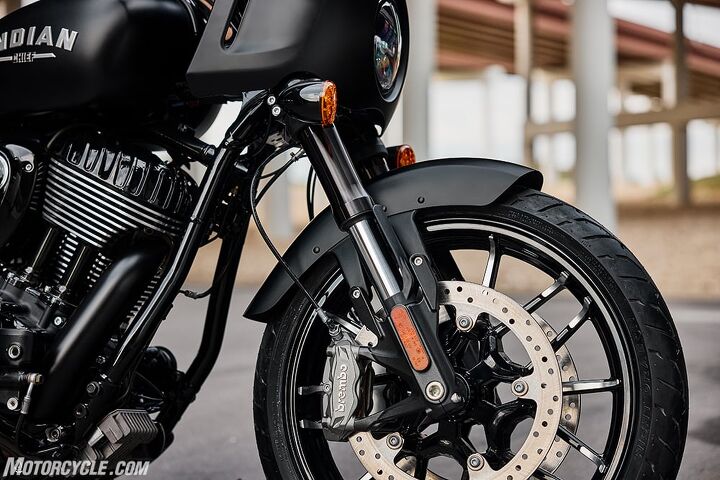
Compared to the standard Chief, and its traditional fork and single disc setup, the Sport Chief gets a KYB inverted fork (non-adjustable) and two 320mm discs paired with radial-mount, 4-pot Brembo calipers.
Moving to the front of the bike, the Sport Chief benefits from a KYB inverted fork, but without any ability for adjustment. Bringing the party to a stop are a pair of 320mm semi-floating discs paired with radial-mount Brembo four-piston calipers. It’s actually the same braking system used on the Challenger, but with different brake pads for the Sport Chief application. In the back are a 300mm rotor and a two-piston caliper.
Putting the rider in a prime position to ground down some pegs, the rider triangle includes mid-mount foot controls, a solo gunfighter seat, and most importantly, six-inch risers (the standard Chief has the bars mounted straight to the triple clamp) for the bars. Depending on your body type or personal style, 10-inch or 4-inch risers are also available, as is a shorter seat and even an extended seat for a passenger (you’ll have to get the passenger pegs, too). So, there is no shortage of options to get the seating position to your liking. As for the quarter fairing itself, it comes standard with a 6-inch windscreen, but taller or shorter versions are available, with or without a flare.
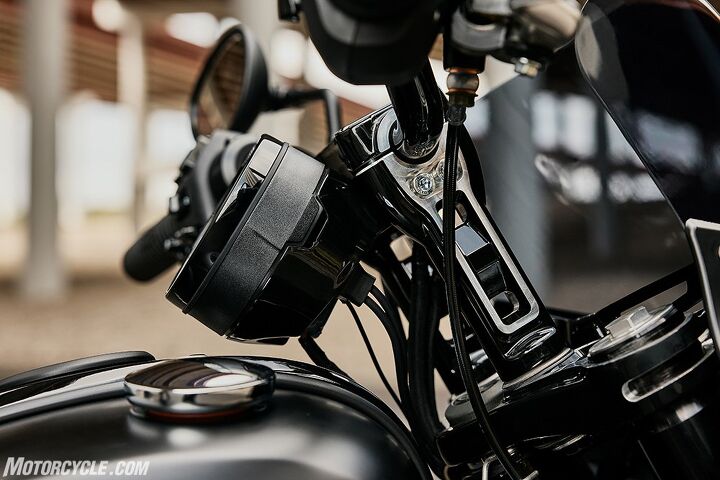
Adjustability is the name of the ergonomic game for the Sport Chief, and the standard 6-inch risers can be swapped for taller (10-inch) or shorter (4-inch) versions from the Indian accessories catalog. These are also compatible across the Chief range.
At the heart of it all is Indian’s signature Thunderstroke air-cooled 49º V-Twin engine and six-speed transmission. With the Sport Chief, you have the option of getting the 111ci version, or you can step it up to 116ci. With a bore of 103.2mm, stroke of 113mm, and an 11.0:1 compression ratio, Indian says the undersquare engine pumps out 120 lb-ft of torque. An impressive number, but if we’re playing tit for tat, Harley says its Milwaukee-Eight 117 makes 125 lb-ft. Petty differences aside, the T-Stroke features rear cylinder deactivation when at a stop to help reduce how much hot air wafts your way while you’re waiting for the red light to turn green.
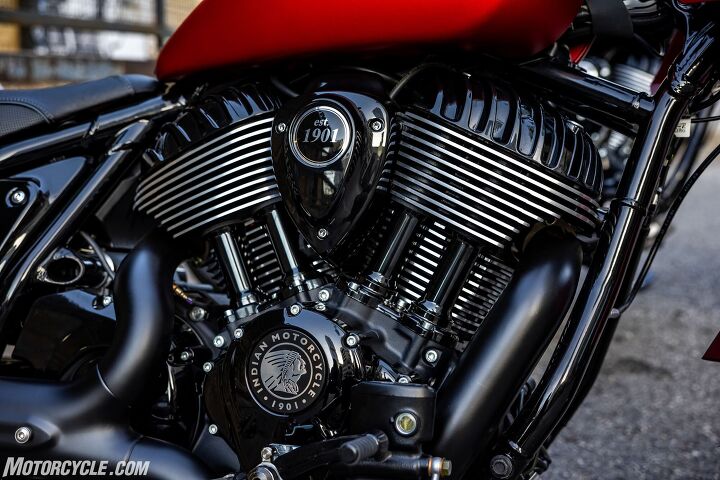
The Thunderstroke engine needs no introduction. The 116ci version we tested is healthy but feels choked with EPA restrictions.
From a mechanical standpoint, those are the Sport Chief’s big talking points, but hidden within the sporty persona of the bike are some impressive tech like cruise control, three different ride modes (Touring, Standard, and Sport), and the 4-inch round TFT display with Indian’s Ride Command tech. Operable with the touch of a finger or through buttons on the left bar, the round dial keeps the aesthetic that befits a bike like the Sport Chief, but it is packed with modern capabilities. The speedo and tach dials look analog, but you also have the ability to swipe with your finger to access different menu screens, including the navigation screen that can provide turn-by-turn directions.
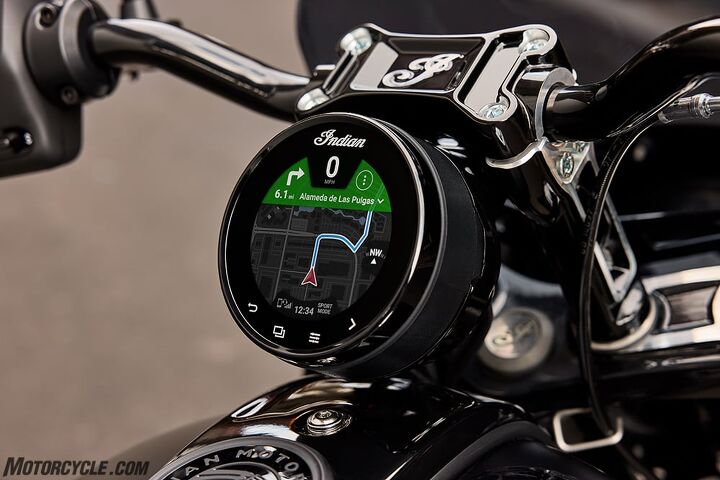
The 4-inch round TFT display is surprisingly informative, easy to use, and still readable even in direct sunlight.
The 2023 Indian Sport Chief comes in four colors: Black Smoke ($18,999), Ruby Smoke ($19,499), Stealth Gray ($19,499), and Spirit Blue Smoke ($19,999).
Riding Impressions
The term sport cruiser is a little oxymoronic if you ask me, but to its credit, the Sport Chief looks the part. Then again, so does the Low Rider S. As far as cruisers go, I’ve long had a soft spot for the ones that attempt to have some sport chops (but don’t tell anyone that).
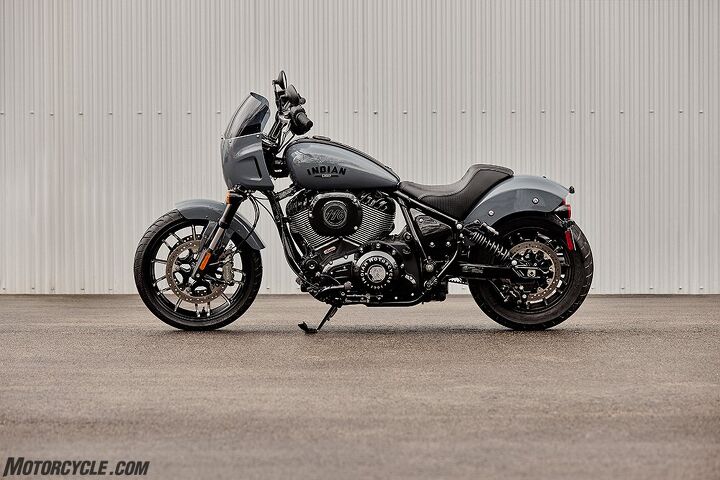
Looks are subjective of course, but as far as cruisers go, the Sport Chief looks pretty good.
A keyless ignition means the fob can stay in your pocket. All you have to do is push the button on the bar to turn on the ignition. Doing so awakens the TFT display with Indian’s flashy intro and disclaimer about motorcycle riding being dangerous. Thumb the starter and the Thunderstroke 116 (in our case) gargles to life. You can tell a hearty and healthy V-Twin rumble wants to come out, but it’s clearly muffled by the Uncle Sam-mandated stock exhaust.
Picking it up off the sidestand isn’t terribly challenging, indicating its 685-pound curb weight is spread out evenly. Before leaving, our ride leader suggested we start our ride in the Standard ride mode, especially as the first section would be through town and numerous stop lights. It was easy to do with only three presses of the touchscreen, and after clunking the trans into first, we were on our way. The Sport Chief pulled away cleanly, albeit with less eagerness than I anticipated. Curious, after only two stop lights I gave the Sport riding mode a try. It was clear to see why Standard was the suggested mode. In Sport acceleration is immediate, which is nice and what I wanted, but as we were riding at normal speeds and at neutral throttle, the bike had a tendency to surge, making it hard to keep it calm and steady. It turns out putting it in Standard mode and sacrificing immediate torque for a smooth ride is the optimal tradeoff.
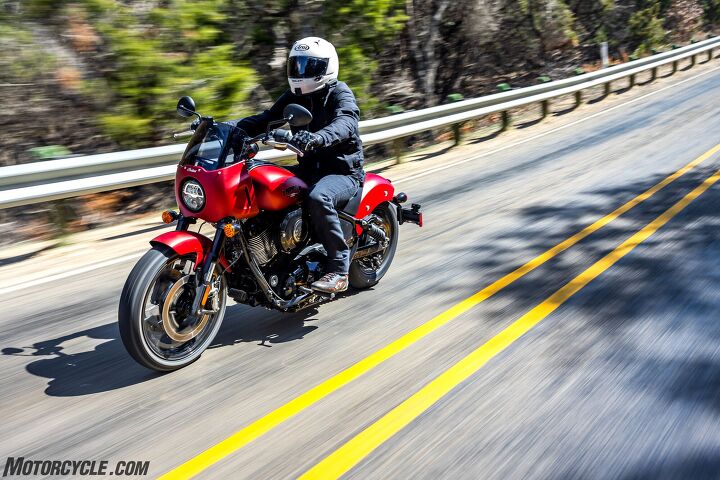
Cruisers in general, and cruisers with sporting chops in particular, often get criticized (and rightly so, in my opinion) for sacrificing shock travel in exchange for low seat heights. The Indian team made a big deal about the suspension on the Sport Chief, so the first order of business was to see how well it could handle some bumps. Luckily Austin, Texas, the destination for our ride, is full of choppy roads and manhole covers.
Three manhole covers in and I can confirm the four inches of shock travel make a big difference. Whereas other cruisers may come with rear shocks but are basically still hardtails that send jolts up the spine over any bump, the Sport Chief actually takes most of that hit. As suspension is supposed to do. So far, so good for the Sport Chief.
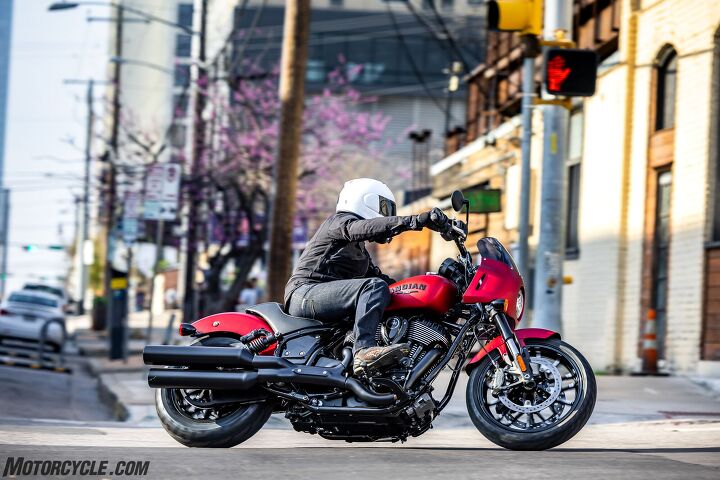
Rolling along through the highways and back roads, I found the Sport Chief’s cockpit to be a fairly comfortable place to be. The mid controls are situated perfectly for this kind of bike, the seat is nicely padded and bolstered, and the standard six-inch bar risers are a good height. If it were me, I would opt for the optional seat to move closer to the bars, but my 5-foot, 8-inch frame is scrawny with short arms. Clearly, your mileage may vary.
It should come as no surprise, but cruising is what this Thunderstroke engine does well. It’ll lope along in sixth gear at highway speeds, and with all that torque, there’s no need to downshift to make a pass. But here’s the catch: peak torque comes at 2,900 rpm, but a distinctive engine vibration starts at 3,000 rpm and continues for at least another thousand revs. Redline hits at 5,000 rpm, so basically, you use the torque if/when you need it but are always mindful of clicking the next gear as soon as you can to keep things smooth. Others in the group who experimented with the 10-inch risers said the vibrations were exacerbated by the taller bars.
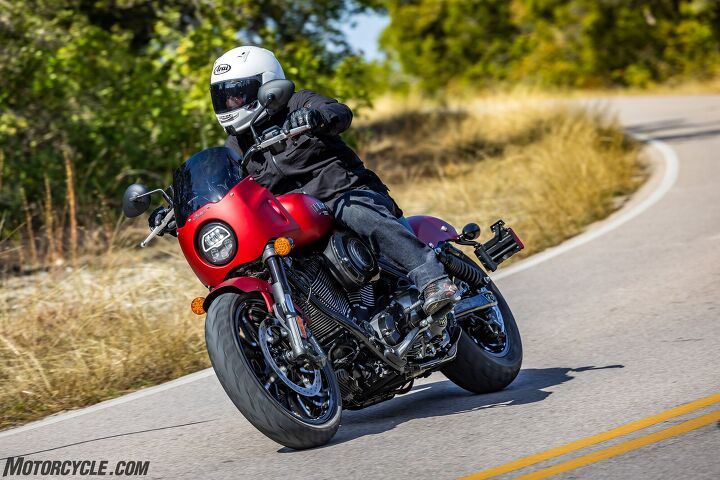
More than just a style piece, the Sport Chief’s quarter fairing does an admirable job deflecting the wind considering its size. I hardly felt any helmet buffeting or gusts coming toward my chest. Different body types and personal preferences will likely appeal to the taller or shorter offerings from Indian, but for me, the stock screen quickly became an afterthought.
As the ride transitioned from boring slab to more exciting back roads, it became time to really explore the Sport in the Sport Chief’s name. Clearly, nobody’s going to be mistaking one of these for a sportbike, but it does feel like a sporty cruiser. Even with a 19-inch front wheel and 28º rake, it turns relatively easily. You’ll touch the peg feeler (and eventually the rest of the peg) down fairly quickly, but it folds up and gives you a few more degrees of lean angle before more rigid hard parts start touching down. Not that you should be exploring these limits, but if you do find yourself there, you’ll see the Sport Chief is pretty capable in that regard.
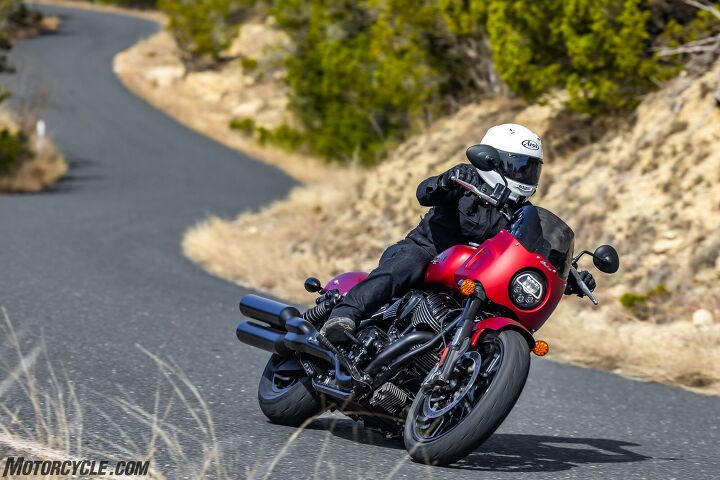
Clearly, this is still a cruiser after all, and with such a long wheelbase, the Sport Chief wants to be guided smoothly from corner to corner, not manhandled and whipped into submission. You can use the two front brakes to control your speed, and the Brembos will give you plenty of stopping power and decent feel to do it, but use all three brakes and the Sport Chief really slows down. If you feel so inclined, some light trail braking helps the long bike into the corners. I found myself using much more of the rear brake to pivot the bike in the direction I wanted. Either method works.
Being the type of riders we are, motojournos sometimes push the limits of what a bike can do – especially when it comes to cruisers. And considering the bike has Sport in its name, we quickly found ourselves navigating the twisty sections of our route at velocities the average Sport Chief owner probably won’t find themselves in (actual speeds are being withheld to protect the guilty). Nonetheless, anticipating what’s next and using the brakes effectively allowed the SC to get through the route a lot quicker than anything this big, long, and low should really have any right to.
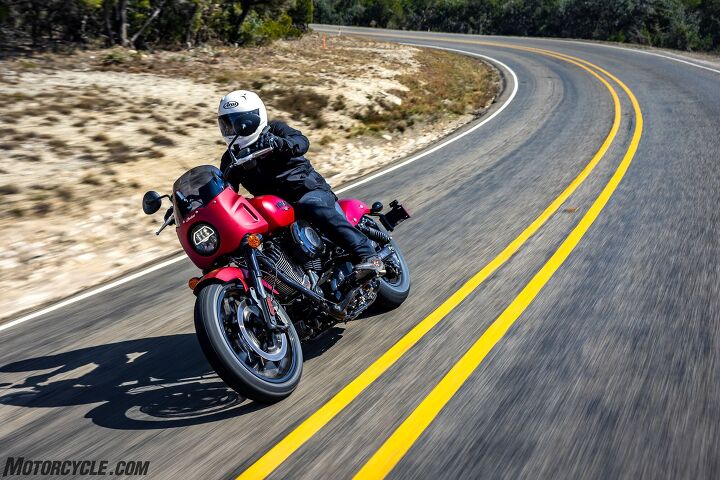
But this is also where we found the limits of the standard suspension. Ramp up the pace and you can blow through the suspension travel at both ends, resulting in a jolt up your spine. The optional suspension upgrades in the Indian catalog will help with this. The thing is, I find it hard to believe the average owner is really going to be pushing to these levels. Ridden within its boundaries and for its intended use, the Sport Chief is really a nice place to be.
Negatives
Does the Sport Chief have some downsides? Of course. As mentioned before, the buzz starting at 3,000 rpm is very noticeable and not something you want to ride with if you can avoid it. Shift early and ride the torque wave. I already mentioned the Sport ride mode is too touchy for everyday riding, so keep it in Standard and twist the throttle a little more. Touring mode wasn’t used because, well, there wasn’t a reason to switch.
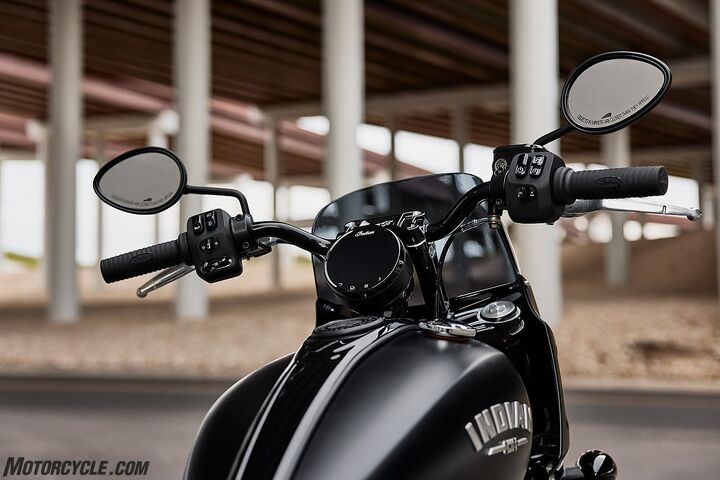
You don’t give much thought to mirrors until you actually need them. I couldn’t position the Sport Chief’s mirrors to see anything useful behind me.
Speaking of touring, this brings us to my next gripe. The mirrors are absolutely useless. The teardrop shape lends itself to giving a decent view behind, but the ball and socket the mirrors are mounted on don’t allow enough articulation to position the mirrors in a usable range. Plenty of bikes have bad mirrors, but usually, I can move them to a spot where I can at least see a little of what’s behind me. With the Sport Chief, I ended up relying exclusively on the shoulder check anytime I wanted to see what was happening on my six.
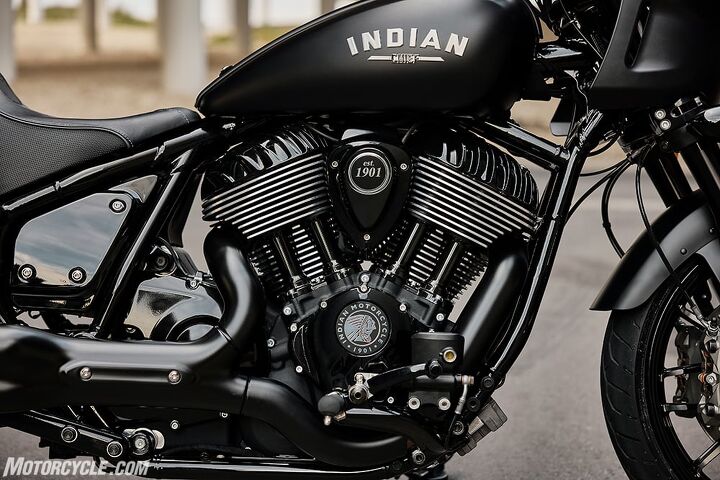
If the front cylinder alone generates enough heat to roast your thighs at a stop, we’d hate to think how hot it gets when both cylinders are firing.
Lastly, there’s the engine. Specifically the heat. You already know about the buzziness, but the Thunderstroke engine also gets really hot. Thankfully, the V-Twin will deactivate the rear cylinder at a stop (and you know this because there’s a symbol on the TFT display), but the front cylinder alone generates plenty of heat as it is and can get you nice and roasted if you’re sitting at a red light for long enough. Then it’s best to rest your right foot on the peg to stay away from the scorching hot exhaust pipes.
Shots Fired
Indian is blatantly gunning for Harley-Davidson every chance it can get, and the Sport Chief is the latest tit for Harley’s tat. It’s interesting how simple changes like longer shocks, different geometry, better suspension, and better brakes can really change a bike, but in the Sport Chief’s case, it definitely gives it more athleticism over the standard Chief. It’s an enjoyable cruiser to ride, with enough muscle and a little bit of cornering chops to please someone who’s, say, a reformed (retired?) sportbike guy. It would be fun to uncork one and really let it breathe, but luckily you can do that on your own through the Indian catalog if the Sport Chief is your jam.
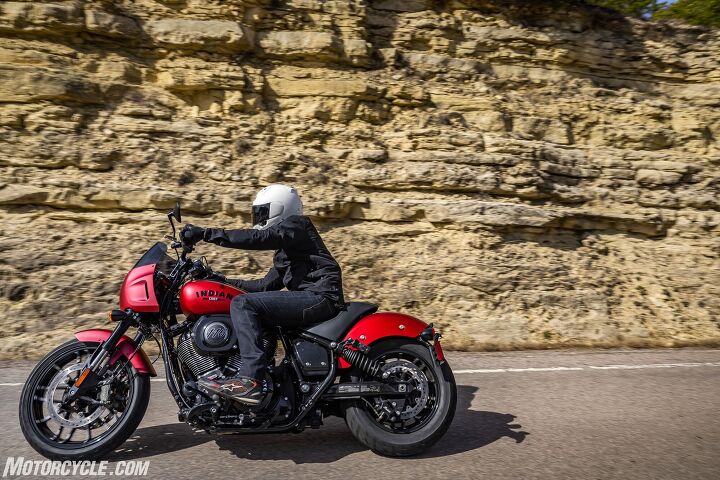
Of course, the big question is how it stacks up against its most obvious rival – Harley’s Low Rider S. Having not ridden one yet it’s impossible to answer that question. But don’t worry, this comparison is already on our to-do list.
| 2023 Indian Sport Chief Specifications | |
|---|---|
| MSRP | $18,999 (Black Smoke), $19,499 (Ruby Smoke, Stealth Gray), $19,999 (Spirit Blue Smoke) |
| Engine Type | 1811 (111 cubic inches) / 1890 cc (116 ci) air-cooled 49-degree V-Twin, OHV, four valves per cylinder, with rear cylinder deactivation |
| Bore and Stroke | 101mm / 103.2mm x 113mm |
| Compression Ratio | 9.5:1 / 11:1 |
| Torque | 108 lb-ft @ 3200 rpm / 120 lb-ft @ 2900 rpm |
| Transmission | 6-speed |
| Final Drive | Belt |
| Front Suspension | KYB 43mm inverted telescopic fork, nonadjustable, 5.1 in (130mm) travel |
| Rear Suspension | Dual FOX piggyback shocks with adjustable preload, 4.0 in (100mm) travel |
| Front Brake | Dual 320mm semi-floating rotors, 4-piston radial-mount Brembo calipers, ABS |
| Rear Brake | Single 300mm disc, 2-piston caliper, ABS |
| Front Tire | 130/60B19 Pirelli Night Dragon |
| Rear Tire | 180/65 B16 Pirelli Night Dragon |
| Rake/Trail | 28° / 4.4 in (111 mm) |
| Wheelbase | 64.6 in (1640 mm) |
| Seat Height | 27 in (686 mm) |
| Curb Weight (Claimed) | 685 lbs |
| Fuel Capacity | 4.0 gal. (not including reserve) |
| Colors | Black Smoke, Ruby Smoke, Stealth Gray, Spirit Blue Smoke |
| Infotainment | 4 in Touchscreen powered by RIDE COMMAND. Model year 2023 bikes include a complimentary 1-year trial of RIDE COMMAND+ (after which, fees apply) which includes features like live weather/traffic and intuitive destination search,. Touchscreen display includes real-time clock; ambient air temperature; heading; audio information display; map/navigation; Bluetooth status for phone and headset; vehicle status (voltage, engine hours, oil change); vehicle info (speed, fuel range, RPM, gear position); current ride data (distance, moving time, stop time, altitude, altitude change); trip meters; ride mode selection; screen brightness; and vehicle trouble code readout. |
| Warranty | 2 Years, Unlimited Miles |
We are committed to finding, researching, and recommending the best products. We earn commissions from purchases you make using the retail links in our product reviews. Learn more about how this works.
Become a Motorcycle.com insider. Get the latest motorcycle news first by subscribing to our newsletter here.
